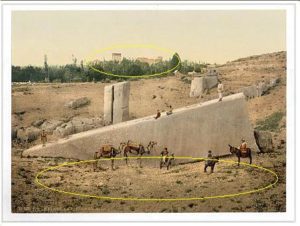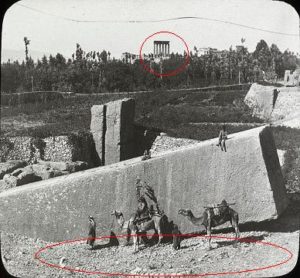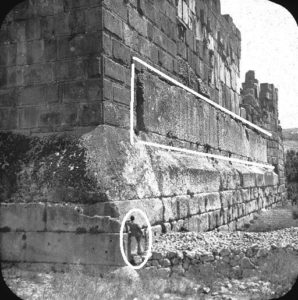
Beside the Stone of the Pregnant Woman, in a quarry near temple ruins at Baalbek, Lebanon, travelers walked unknowingly on an even larger hand-carved stone which lay hidden for centuries. In mid-2014, the largest known man-carved limestone block, estimated to weigh 1,650 tons, was discovered by German archeologists, in the location circled in this photo from the past. (See also the 6 columns of the Temple of Jupiter circled in the distance.)

The angled, 1,000-ton, Stone of the Pregnant Woman (sometimes called Stone of the Sun), shown above, had been surpassed in size in the 1990s, with the discovery of a 1,242-ton stone block, in the same quarry across the road. Now, the newly-discovered stone has surpassed that second monolith.
These three stone blocks are believed to have been intended for use in the nearby Roman temple complex, possibly in a manner similar to that of the Trilithon stones, three 800-ton stones which are incorporated into the foundation of the Temple of Jupiter (as marked in white below), in what has been considered a marvel of stone-moving engineering. The Trilithon stones of Baalbek are considered the largest stones ever incorporated into a known structure.

The excavation, led by Jeanine Abdul Massih, was conducted by a team from the German Archeological Institute, with a goal of investigating techniques of ancient mining and transporting large stones.
The quarry and temple at Baalbek provided an ideal location for such a study, as it not only presented the largest known hand-carved blocks still in situ in the nearby limestone quarry; but also had the example of the Trilithon stones.
The Discovery Was Announced in December, 2014
The announcement of the 1,625-ton stone discovery was issued by several sources in December, 2014. Here is one description of the project:
In the summer of 2014 the Oriental Department of the German Archaeological Institute conducted excavations in the stone quarry of Baalbek/Ancient Heliopolis, in Lebanon. There lies the monolith “Hajjar al-Hibla” (Stone of the Pregnant Woman). Similar stone blocks of a 20m-length were used for the podium of the huge Temple of Jupiter in the Roman sanctuary of Baalbek.
The aim of this year’s excavations was to find new data about the mining techniques and the transporting of the megaliths. Archaeologists documented processing traces and investigated the old dumps of the mining activities, in order to locate datable and stratifiable sherds of pottery and small finds.
See the rest of this article and a picture of the newly unearthed stone here.
Read on to find out the following:
- Is the function of the Trilithon of Baalbek linked to the lost cedars of Lebanon?
- How did the Romans move the stones?
- Video: What did the Baalbek temple complex look like?
- Why did the Romans build their largest temple so far from home?
- Why did the Baalbek temple complex fall into ruin?
- What lies in the Tell underneath the Baalbek temple complex?
- How are archeologists coordinating research at the Baalbek archeological site?



